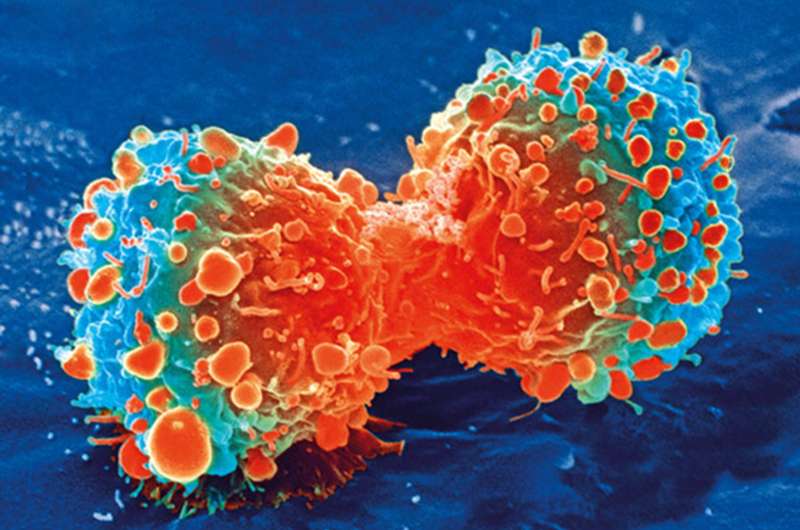New drug compounds could provide non-toxic, effective way to inhibit enzymes that cause cancers

Drug compounds being developed at Purdue University could effectively target and inhibit protein kinase enzymes and secondary mutated versions that drive multiple types of cancers. The compounds are non-toxic compared to conventional drugs, potentially eliminating adverse patient side effects.
"Protein kinases are an important class of proteins that are involved in cell signaling. They regulate a variety of processes such as cell growth, death (apoptosis) and migration. There are about 600 different protein kinases in a human cell," said Herman Sintim, a professor in Purdue's Department of Chemistry and developer of the innovation. "Because of their involvement in cell signaling, protein kinases are also involved in cancer formation. For a variety of cancers, these protein kinases either become mutated and cause abnormal cell growth or they undergo kinase duplication, both inevitably causing cancer."
Sintim said conventional methods, which generally use cytotoxic drugs to kill cancer cells pose several limitations.
"Typical treatments concentrate on developing small molecules to inhibit kinases. This approach is different to the previous ways medicinal chemists would target cancer, which involved using cytotoxic drugs. Cytotoxic drugs indiscriminately destroy DNA or cell metabolism apparatus or proteins and since every cell contains these building blocks the drugs attack every cell in the body instead of just the cancerous ones," he said. "As the name suggests, cytotoxic drugs are very toxic and can have severe adverse side effects such as hair loss, vision problems and neurological problems. New approaches that go after driver mutations that may only be abundant in cancer cells may lead to targeted therapy with less side effects."
Sintim has developed a concept called "azo-click-it/staple-it" that can be used to discover protein kinase inhibitors that not only targets initial kinases that drive cancer but also targets secondary mutations that can reappear after initial inhibitor treatment. The findings were recently published in ACS Medicinal Chemistry Letters.
Sintim's therapeutic strategy was demonstrated by developing a promising acute myeloid leukemia (AML) drug class.
"We tackled AML first because it's a heterogeneous, complex disease. The one-year survival rate for patients over 65 with acute myeloid leukemia is approximately less than 20 percent. In comparison, breast cancer has a one-year survival rate of over 90 percent," Sintim said. "One of the reasons why elderly AML patients have a very low survival rate could be due to the fact that in general they do not tolerate well high doses of the conventional drugs, such as cytarabine and daunorubicin. Additionally, the elderly are not typically good candidates for allogeneic hematopoietic cell transplantation, which can extend life by several years.
"Acute Myeloid Leukemia also does not have a patient population as large as other cancers so perhaps the motivation to expend resources to find AML cures is not that great."
Sintim said about 30 percent of AML patients carry a mutation in a protein kinase called FLT 3, which is called a driver mutation as it drives the acute myeloid leukemia.
"There are current inhibitors out there that target FLT3, but clinical trials showed that after a few months of treatment a secondary mutation would form making the inhibitors ineffective and consequently the cancer would come back. There is currently no single FLT3 kinase inhibitor that provides a complete cure to AML," he said. "We have developed a platform to create new types of molecules that not only target FLT3 but also target other signaling pathways that enhance FLT3 signaling or that could emerge and reinstate the cancer. We believe our compounds could handle these secondary mutations potentially providing a complete cure to AML."
The technology could be adapted to treat other cancers for which there are no effective therapeutics, Sintim added.
"Our first goal is to develop technologies that would allow us to quickly develop new chemical entities that would inhibit protein kinases completely. Our platform, which can be used to quickly explore chemical space, can target almost any protein kinase that needs an inhibitor. These compounds don't just work for AML," he said. "We believe our platform can also be applied to certain types of lung cancers, breast cancers and thyroid cancers, different cancers that are driven by protein kinases and suffer from secondary mutations."
The Purdue Research Foundation's Office of Technology Commercialization has patented the technology. Sintim is seeking partners interested in studies or further developing the compounds.
"We have done some initial animal efficacy studies that showed our compounds worked beautifully in a mouse AML model," he said. "We are confident that after further developments we will be able to develop a complete anti-AML therapeutic."
A second paper on the platform is scheduled to be published in May.
More information: Xiaochu Ma et al. Identification of New FLT3 Inhibitors That Potently Inhibit AML Cell Lines via an Azo Click-It/Staple-It Approach, ACS Medicinal Chemistry Letters (2017). DOI: 10.1021/acsmedchemlett.6b00468
















